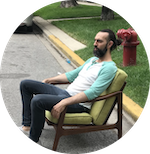Notes on Directing Improvised Scenes (on camera)
Improv can bring about lots of happy surprises but it isn’t guaranteed to tell a good story. Directing improv was for the most part about making sure the story was being written in a compelling way, beyond the great moment-to-moment work done by the actors.
By the end, I was starting each day by telling the actors that it might not be funny at first, or it might not feel funny, but it was my job to get the story there through the editing, so they just had to be real—to eliminate the pressure to be funny or get discouraged by the first few takes.
We did the first take without direction to see how things played out. As they hit certain story beats, I would cross them off my outline on a clipboard. After we had hit the major story beats, we experimented with different attitudes, reactions, storylines, etc.
Throughout the filming, I jotted down funny lines that I wanted to try, so once we had the story down, we did pick up takes where the crew and I tossed out lines for them to say, just to try out funny things. Occasionally I had them repeat a line from earlier, usually something that established the premise or made one of the reveals clearer, just so it would be easier to get to the heart of the matter in the edit.
There was a pattern where a couple minutes into a take, the actors would get stuck in the story and there would be some kind of argument or impasse. To get around the impasses, I cut and then pulled the actors aside, separately, to give them a new approach to try. Then another take.
I think that dramatic improv training, like that that you do in Meisner classes is more focused on living your truth, honesty, etc. That’s what it’s designed for, to get you to be able to act naturally and open up emotionally, to live truthfully moment to moment.
Comedic improv training, where students and performers spend a lot of time improvising for public audiences, learning via laughter how to move a story and get laughs. Comedic improvisers learn techniques to get out of stalls – heightening, dynamic shifts, edits, tactic switches, game playing, etc. But they may be too quick to sound the “boring alarm” and move on too quickly.
So, the type of direction required depends on the actor’s improv background.
